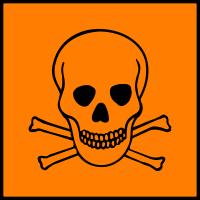

NAMES AND DATABASE IDS
NAMES AND DATABASE IDS
Names Database IDs
|
IUPAC name
|
|
2,2,2-trichloroethane-1,1-diol
|
|
|
|
|
IUPAC Traditional name
|
|
|
Brand Name
|
|
Somnote
|
|
Aquachloral Supprettes
|
|
|
|
|
Synonyms
|
|
Trichloroacetaldehyde hydrate
|
|
Chloral hydrate solution
|
|
Chloral hydrate solution
|
|
‘Ground joint separation aid’ Fluka
|
|
Chloral hydrate
|
|
Chloral hydrate
|
|
Trichloroacetaldehyde monohydrate
|
|
Tradenames: Aquachloral, Novo-Chlorhydrate, Somnos, Noctec, Somnote
|
|
水合氯醛 溶液
|
|
水合氯醛 溶液
|
|
`磨口连接头分离助剂' Fluka
|
|
三氯乙醛 水合物
|
|
氯醛 水合物
|
|
|
|
|
CAS Number
|
|
|
EC Number
|
|
|
MDL Number
|
|
|
Beilstein Number
|
|
|
PubChem SID
|
|
|
PubChem CID
|
|
|
CHEBI ID
|
|
|
ATC CODE
|
|
|
CHEMBL
|
|
|
Chemspider ID
|
|
|
DrugBank ID
|
|
|
KEGG ID
|
|
|
Unique Ingredient Identifier
|
|
|
Wikipedia Title
|
|
DATA SOURCES
DATA SOURCES
All Sources Commercial Sources Non-commercial Sources
CALCULATED PROPERTIES
CALCULATED PROPERTIES
JChem
ALOGPS 2.1
|
Acid pKa
|
9.509397
|
H Acceptors
|
2
|
H Donor
|
2
|
LogD (pH = 5.5)
|
0.69231254
|
LogD (pH = 7.4)
|
0.6889953
|
Log P
|
0.69235504
|
Molar Refractivity
|
29.2457 cm3
|
Polarizability
|
11.635822 Å3
|
Polar Surface Area
|
40.46 Å2
|
Rotatable Bonds
|
1
|
Lipinski's Rule of Five
|
true
|
|
Log P
|
0.88
|
LOG S
|
-0.58
|
Solubility (Water)
|
4.34e+01 g/l
|
PROPERTIES
PROPERTIES
Physical Property
Safety Information
Pharmacology Properties
Product Information
Bioassay(PubChem)
|
Solubility
|
|
793 mg/mL at 25 oC [YALKOWSKY,SH & HE,Y (2003)]
|
 Show
data source Show
data source
|
|
|
Apperance
|
|
Colorless solid
|
 Show
data source Show
data source
|
|
|
Melting Point
|
|
57 °C(lit.)
|
 Show
data source Show
data source
|
|
57°C
|
 Show
data source Show
data source
|
|
|
Boiling Point
|
|
98°C
|
 Show
data source Show
data source
|
|
|
Flash Point
|
|
16 °C
|
 Show
data source Show
data source
|
|
60.8 °F
|
 Show
data source Show
data source
|
|
|
Density
|
|
1.20 g/mL at 20 °C
|
 Show
data source Show
data source
|
|
1.43 g/mL at 20 °C
|
 Show
data source Show
data source
|
|
1.91 g/cm3
|
 Show
data source Show
data source
|
|
|
Hydrophobicity(logP)
|
|
0.99 [HANSCH,C ET AL. (1995)]
|
 Show
data source Show
data source
|
|
|
pKa
|
|
9.66, 11.0
|
 Show
data source Show
data source
|
|
|
pH
|
|
3.5-5.5 (20 °C, 10%)
|
 Show
data source Show
data source
|
|
|
RTECS
|
|
FM8750000
|
 Show
data source Show
data source
|
|
|
European Hazard Symbols
|
 Flammable (F) Flammable (F)
|
 Show
data source Show
data source
|
 Toxic (T) Toxic (T)
|
 Show
data source Show
data source
|
|
|
UN Number
|
|
3286
|
 Show
data source Show
data source
|
|
|
MSDS Link
|
|
|
German water hazard class
|
|
2
|
 Show
data source Show
data source
|
|
|
Hazard Class
|
|
3
|
 Show
data source Show
data source
|
|
|
Packing Group
|
|
2
|
 Show
data source Show
data source
|
|
|
Risk Statements
|
|
11-23/24/25-36/38-39/23/24/25
|
 Show
data source Show
data source
|
|
25-36/38
|
 Show
data source Show
data source
|
|
R22 R36 R37 R38
|
 Show
data source Show
data source
|
|
|
Safety Statements
|
|
16-26-36/37-45
|
 Show
data source Show
data source
|
|
25-45
|
 Show
data source Show
data source
|
|
26-45
|
 Show
data source Show
data source
|
|
|
GHS Pictograms
|

|
 Show
data source Show
data source
|

|
 Show
data source Show
data source
|

|
 Show
data source Show
data source
|
|
|
GHS Signal Word
|
|
Danger
|
 Show
data source Show
data source
|
|
|
GHS Hazard statements
|
|
H225-H301-H312-H315-H319-H332-H370
|
 Show
data source Show
data source
|
|
H301-H315-H319
|
 Show
data source Show
data source
|
|
|
GHS Precautionary statements
|
|
P210-P260-P280-P301 + P310-P305 + P351 + P338-P307 + P311
|
 Show
data source Show
data source
|
|
P301 + P310-P305 + P351 + P338
|
 Show
data source Show
data source
|
|
|
Personal Protective Equipment
|
|
Eyeshields, Faceshields, Gloves, type P2 (EN 143) respirator cartridges
|
 Show
data source Show
data source
|
|
Faceshields, full-face respirator (US), Gloves, Goggles, multi-purpose combination respirator cartridge (US), type ABEK (EN14387) respirator filter
|
 Show
data source Show
data source
|
|
|
RID/ADR
|
|
UN 3286 3/PG 2
|
 Show
data source Show
data source
|
|
|
Drug Control
|
|
USDEA Schedule IV
|
 Show
data source Show
data source
|
|
|
Admin Routes
|
|
Oral codeine/syrup, rectal suppository
|
 Show
data source Show
data source
|
|
|
Bioavailability
|
|
well absorbed
|
 Show
data source Show
data source
|
|
|
Excretion
|
|
bile, feces, urine (various metabolites not unchanged)
|
 Show
data source Show
data source
|
|
|
Half Life
|
|
8–10 hours in plasma
|
 Show
data source Show
data source
|
|
|
Metabolism
|
|
converted to trichloroethanol, hepatic and renal
|
 Show
data source Show
data source
|
|
|
Legal Status
|
|
Schedule IV (US)
|
 Show
data source Show
data source
|
|
|
Pregnancy Category
|
|
C (US)
|
 Show
data source Show
data source
|
|
|
Purity
|
|
≥98.0% (T)
|
 Show
data source Show
data source
|
|
≥99.5%
|
 Show
data source Show
data source
|
|
≥99.7%
|
 Show
data source Show
data source
|
|
99.5-101%
|
 Show
data source Show
data source
|
|
|
Concentration
|
|
1 g/mL
|
 Show
data source Show
data source
|
|
|
Grade
|
|
p.a.
|
 Show
data source Show
data source
|
|
SAJ first grade
|
 Show
data source Show
data source
|
|
SAJ special grade
|
 Show
data source Show
data source
|
|
|
Compostion
|
|
chloral hydrate, 32%
|
 Show
data source Show
data source
|
|
methanol, 26%
|
 Show
data source Show
data source
|
|
|
Suitability
|
|
complies for appearance of solution
|
 Show
data source Show
data source
|
|
complies for reaction against H2SO4
|
 Show
data source Show
data source
|
|
|
Ignition Residue
|
|
≤0.1% (as SO4)
|
 Show
data source Show
data source
|
|
|
Impurities
|
|
≤0.002% heavy metals (as Pb)
|
 Show
data source Show
data source
|
|
≤0.1% non-volatile matter
|
 Show
data source Show
data source
|
|
chlor alcoholate, complies
|
 Show
data source Show
data source
|
|
organic volatile impurities, complies (GC)
|
 Show
data source Show
data source
|
|
residual solvents, complies
|
 Show
data source Show
data source
|
|
|
Antion Traces
|
|
chloride (Cl-): ≤50 mg/kg
|
 Show
data source Show
data source
|
|
|
Quality
|
|
crystallized
|
 Show
data source Show
data source
|
|
meets analytical specification of Ph. Eur., BP, USP
|
 Show
data source Show
data source
|
|
|
Linear Formula
|
|
Cl3CCH(OH)2
|
 Show
data source Show
data source
|
|
DETAILS
DETAILS
 DrugBank
DrugBank
 Wikipedia
Wikipedia
 Sigma Aldrich
Sigma Aldrich
DrugBank -
DB01563

|
| Item |
Information |
|
Drug Groups
|
illicit; experimental |
|
Description
|
A hypnotic and sedative used in the treatment of insomnia. The safety margin is too narrow for chloral hydrate to be used as a general anesthetic in humans, but it is commonly used for that purpose in animal experiments. It is no longer considered useful as an anti-anxiety medication. [PubChem] |
| Indication |
Mainly used as a hyponotic in the treatment of insomnia; however, it is only effective as a hypnotic for short-term use. May be used as a routine sedative preoperatively to decrease anxiety and cause sedation and/or sleep with respiration depression or cough reflex. |
| Biotransformation |
Metabolized by the liver and erythrocytes to form trichloroethanol, an active metabolite. This reaction is catalyzed by alcohol dehydrogenase and other enzymes. Oxidation of chloral hydrate and trichloroethanol to trichloroacetic acid in the liver and kidneys also occurs to a lesser extent. Trichloroethanol also undergoes glucuronidation to produce an inactive metabolism. |
| Absorption |
Rapidly absorbed in the GI tract following oral or rectal administration. Chloral hydrate and its active metabolite, trichloroethanol, have been detected in CSF, umbilical cord blood, fetal blood, and amniotic fluid. |
| Elimination |
Trichloroethanol, trichloroethanol glucuronide, and trichloroacetic acid are excreted in the urine. Some trichloroethanol glucuronide may be secreted into bile and excreted in the feces. |
| External Links |
|
|
Sigma Aldrich -
C8383

|
Application
Sedative/hypnotic that is used as an anesthetic for laboratory and farm animals. |
Sigma Aldrich -
23100

|
Other Notes
Sales restrictions may apply |
Sigma Aldrich -
84670

|
Application
medium for the separation of ground joints sticking together
Other Notes
Sales restrictions may apply |
PATENTS
PATENTS
 PubChem Patent
PubChem Patent
 Google Patent
Google Patent
